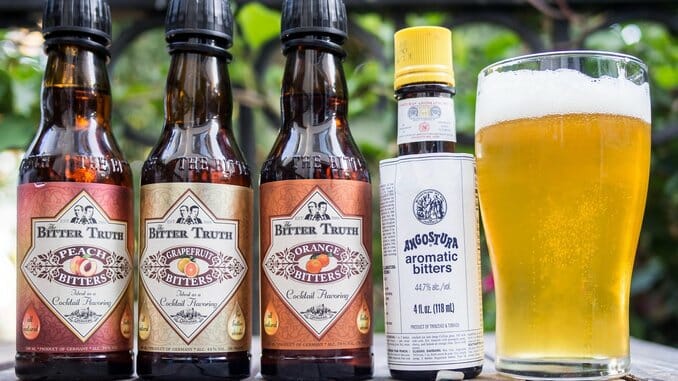DIY Flavored IPAs with Cocktail Bitters
Photos by Julie Verive
Love fruity IPAs? You’re not alone, but why settle for whatever combinations of beer and fruit you can find for sale at your local craft beer retailer? Why not concoct your own custom-flavored IPA — no brewing required? Just take a page from the bartender’s playbook and reach for a bottle of cocktail bitters.
This was the idea proposed by the marketing department of The Bitter Truth, a 10-year-old manufacturer of cocktail ingredients based in Germany. And they offered to send me a few bottles of bitters to try for myself. I did a few rounds of taste testing with different beers and different bitters — both from The Bitter Truth and from my own collection of cocktail bitters, and while the initial results were not unexpected, my tests did lead to some interesting findings. I’ve even added a bottle of grapefruit bitters to my beer fridge.
The next evolution in IPA
Adding fruit to a hoppy, pale base ale is just the latest mutation in IPA’s DNA. From the India Pale Ale to the American IPA to the West Coast IPA, then double and triple IPAs, to the white, red and black variations, to session IPAs and hazy IPAs, many branches have grown from the style’s beginnings in 19th century England. Many beer-purists resent the rise of these adulterated ales, but they are a vocal minority. Fruit-tinged IPAs and other styles — whether the brews are infused with real fruit or engineered with flavor extracts — are an undeniably popular trend that shows no sign of slowing. Love them or hate them, fruit-flavored IPAs (and other styles) are impacting craft beer culture in two big ways. They are approachable entry points to the world of flavorful craft beer for drinkers who haven’t yet discovered everything the craft beer industry has to offer, and they give beer lovers (and beer writers) something to talk (and argue) about.
Personally, I’m fairly ambivalent towards the majority of flavored IPAs. A couple of years ago they seemed pretty exciting, and when Ballast Point was first experimenting with draft-only Sculpin variants, I’d actually hunt out specialty tappings. I was excited to buy the first six packs of Grapefruit Sculpin, and I’ve downed more than a few bottles of it since. But I’ve found most of the newer entries into the field — from Green Flash Brewing’s Tangerine Soul Style to Passionfruit Pinner from Oskar Blues — distractingly artificial and far too fruity. Even the once delightful Grapefruit Sculpin today seems closer to drinking a grapefruit candy than the pithy and aromatic Grapefruit Sculpin of the past (unsurprising when you consider how much the brewery has had to scale production to meet national demand for its brews).
The market, though, has spoken: there’s nearly an unquenchable thirst for IPAs that highlight the flavors of fruit. I may not love the trend — preferring instead the approach of breweries like Firestone Walker who are pushing the fruit flavors into IPAs using just new hop varieties as in the Luponic Distortion series — but the fruited IPA craze is fueling further growth in the craft beer industry.
D-I-Why?

Do-it-yourself projects are polarizing. For every person who’s interested in getting their hands dirty to make something for themselves there’s another person who thinks the extra effort is stupid. The idea of adulterating a craft beer with bitters is sure to rankle some traditionalists and send shivers up the spine of some brewers. This idea isn’t about saving money or making things easier or trying to find a better way; it’s about testing a theory and sharing the results. I hope you can get past the urge to comment about how stupid/wrong/offensive the idea is and maybe even get inspired to try it yourself.
Just a dash will do it
I sat down with a few bottles of bitters (Grapefruit, Orange, and Peach from The Bitter Truth, and a bottle of the ubiquitous Angostura bitters) and a few cans of beer (Swami IPA from Pizza Port Brewing and some Bud Light) for the first tasting. It was difficult at first to get the dosing right; my tasters and I settled on about a dash of bitters for a 12-ounce serving as the sweet spot. It works out to about one drop of bitters per ounce of beer. At this concentration, a glass of Swami IPA dosed with grapefruit bitters had the tell-tale citrus top note in the aroma, but the distinctive flavor of the bitters didn’t overwhelm the hops or the intrinsic ”beeryness” of the Swami the way a full two dashes per pint did.
-

-

-

-

-

-

-

-

-

-

-

-

-

-

-

-

-

-

-

-

-

-

-

-

-

-

-

-

-

-

-

-

-

-

-

-

-

-

-

-









































